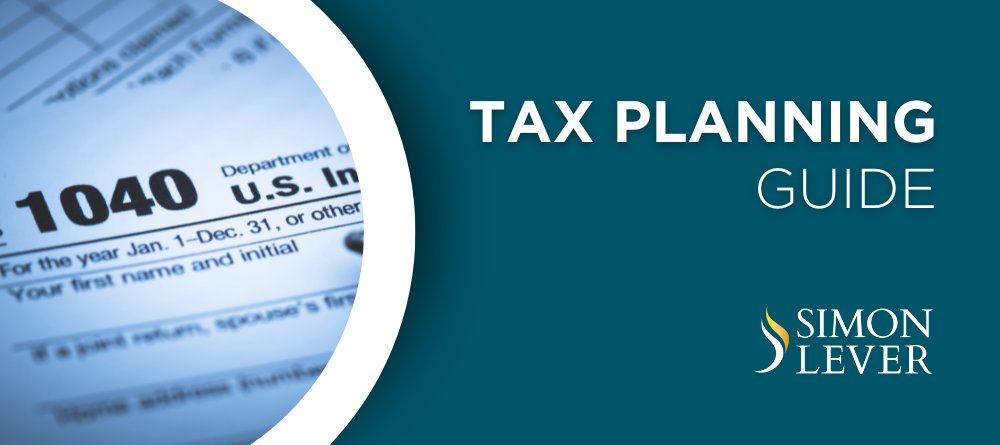2023 Tax Planning Guide

As we reflect on a year of inflation, rising interest rates, low unemployment rates, and global conflicts, 2023 has certainly been a year of adapting and evolving to ever-changing economic conditions. The one constant is Simon Lever’s commitment to providing personalized advice when it matters most, helping you navigate changes and reach your business goals.
Whether you are working with Simon Lever for individual or business tax preparation, this year’s tax planning guide will highlight opportunities, strategies, and considerations to optimize your tax position.
This information should be used as a reference guide — to remind and prompt questions of your Simon Lever advisor. It is not a substitute for direct conversations and the personal service you expect from Simon Lever. We recommend consulting with your Simon Lever advisor for more details about how this information may impact you.
Important 2023 Tax Filing Deadlines
| Tax Filing Type | Deadline (for Calendar Year Entities) |
|---|---|
|
March 15, 2024 |
|
April 15, 2024 |
|
May 15, 2024 |
|
September 16, 2024 |
|
September 30, 2024 |
|
October 15, 2024 |
|
November 15, 2024 |
Tax Strategies & Opportunities
(quick links)
For Businesses
- Equipment and Asset Purchases
- Qualified Improvement Property
- Prepaying Expenses
- Damaged and/or Obsolete Items
- Cash Basis of Accounting
- Cost Segregation for Real Property
- Meals & Entertainment Expenses
- Capitalization of Research & Development Expenditures
- Business Interest Expense Limitations
- Employee Retention Tax Credit
Tax Strategies & Opportunities for Individuals
Investments
As the year comes to a close, take some time to review your investments and determine which strategies will help you meet your financial goals. Here are a few considerations as you prepare for the year-end:
- Consider capital losses to offset capital gains. Take the time to review your investment portfolio and consider whether selling losers to offset gains may be an appropriate strategy for you. Capital losses can offset capital gains plus up to $3,000 of other income. And there is no time limit on applying excess capital losses. They may be carried forward to offset future capital gains.
- Be aware of the wash-sale rule. The wash-sale rule indicates that the IRS will not allow a tax loss to be applied if you purchase substantially identical securities within 30 days of a sale. Keep this in mind as you plan your strategies.
- Consider gifting non-cash assets. Giving of non-cash assets can yield significant tax benefits. If you have appreciated stock (or mutual fund shares) that you have held more than a year, and you plan to make significant charitable contributions before year-end, consider keeping your cash and donating the stock instead. You will avoid paying tax on the appreciation but will still be able to deduct the donated property’s full value. However, if the stock is now worth less than when you acquired it, sell the stock, take the loss, and then give the cash to charity.
Virtual Currency & Digital Assets
The complexity and variety in the virtual currency and digital asset environment continues to evolve. As you prepare to consult with your advisor, here are some considerations to keep in mind:
- If you bought, sold, received, or exchanged any financial interest in a virtual currency or digital asset during the year, you may have a tax reporting requirement.
- The wash-sale rules mentioned under the investment section do not currently apply to virtual currency and digital assets.
- A significant decline in value, even for a bankrupt cryptocurrency, does not equate to a loss deduction unless you sell the cryptocurrency because the property is not considered worthless and could appreciate in the future.
Retirement Plan & Health Savings Account (HSA) Contributions
Now is the perfect time to review your retirement and health savings account contributions and adjust as needed. Consider the following as you plan:
- Know the maximum retirement contributions you are able to make:
- Individuals can contribute up to $22,500 to a 401(k), plus $7,500 if age 50 or up, until December 31, 2023.
- Individuals can contribute up to $6,500 to an IRA, plus $1,000 if age 50 or up, until April 15, 2024.
- Maximize your health savings account contributions:
- If you are enrolled in a high-deductible health plan, you may be eligible to make tax-deductible contributions to an HSA of up to $7,750 for family coverage or $3,850 for individual coverage. An additional $1,000 is permitted if you are 55 or older by the end of the year.
Itemized Deductions
Did you know that itemizing deductions can provide additional tax benefits?
- The IRS provides a standard deduction of $27,700 (married filing jointly) or $13,850 (single). However, if you itemize your deductions, you have increased flexibility in managing your income. Itemized deductions include:
- State and local taxes capped at $10,000
- Home mortgage interest
- Charitable contributions
- Consider a strategy of bunching your charitable contributions into one year to get a larger itemized deduction. This strategy works well when combined with a donor-advised fund.
Education
Education funding continues to be a focus, and there are key tactics to consider as you plan for education costs.
- 529 plans have multiple benefits to consider as you plan for education funding.
- The use of 529 plans is a common way to help fund not only college costs, but also K–12 education expenses and college loan debt. While contributions to 529 plans are not tax-deductible for federal income tax purposes, earnings grow tax-free and — if used to pay for the beneficiary’s college expenses — are never taxed. Contributions to a 529 plan are deductible for Pennsylvania tax purposes, resulting in a 3.07% tax deduction. Pennsylvania taxpayers can deduct up to $17,000 in contributions per beneficiary per year ($34,000 if married filing jointly, assuming each spouse had income of at least $17,000) from their Pennsylvania taxable income for the purposes of determining their state income taxes. Interest on student loans began accruing September 1, 2023 and loan payments resumed in October since President Biden’s student loan forgiveness program was struck down by the US Supreme Court in June. As a reminder, up to $2,500 of student loan interest may be deductible, subject to modified adjusted gross income thresholds.
Green Energy Tax Credits
If you have made or are considering home upgrades, the residential clean-energy property credit is equal to 30% of the cost of solar panels, solar powered water heaters, geothermal heat pumps, and a few additional types of improvements. The energy-efficient home improvement credit is 30% of the cost of insulation, boilers, central air conditioning system, water heaters, heat pumps, exterior doors, and windows that meet certain energy efficient ratings. The energy-efficient home improvement credit of 30% has different annual limits based on the specific type of qualified improvement.
Tax Strategies & Opportunities for Businesses
Equipment & Asset Purchases
If you have or are considering the purchase of equipment and assets for your business, take the following strategies and updates into consideration.
- Current tax law provides two primary options for accelerating depreciation:
- Section 179 depreciation can be utilized to deduct 100% of the cost of eligible additions up to $1,160,000. There is a phase-out of this type of depreciation deduction when eligible additions exceed $2,890,000 and there are other limitations that could reduce the maximum amount that can be claimed.
- New in 2023 Pennsylvania conformed to the Federal Section 179 deduction limitations which is a significant increase from PA’s previous deduction limit of $25,000.
- Bonus depreciation can be utilized to deduct 80% of the cost of eligible additions in the year of acquisition. There is no dollar limit to this deduction (some restrictions apply).
- In 2024 Bonus depreciation is reduced to 60% as it continues to be phased out.
- Businesses can consider accelerating purchases planned for the first quarter of 2024 into the 2023 calendar year to accelerate tax deductions.
- Be aware that there are certain depreciation limitations on vehicles and property that is partially used personally.
- To be eligible for depreciation, assets must be received and available for use, not just ordered.
- Section 179 depreciation can be utilized to deduct 100% of the cost of eligible additions up to $1,160,000. There is a phase-out of this type of depreciation deduction when eligible additions exceed $2,890,000 and there are other limitations that could reduce the maximum amount that can be claimed.
Qualified Improvement Property
If you completed commercial property improvements, be sure to review them with your advisor to determine potential tax benefits. Eligible interior renovations to a commercial property may qualify for a 15-year depreciable life or accelerated depreciation in 2023. This excludes elevators, escalators, building enlargement, and building interior structural improvements.
Prepaying Expenses
Consider using prepaid accounts for eligible expenses. Certain expenses are eligible for a tax deduction when prepaid in the current year with the benefit of the expense occurring in the following year. Some eligible expenses include insurance, property taxes, and supplies.
Damaged and/or Obsolete Items
Don’t forget to evaluate inventory and identify damaged and/or obsolete items. The carrying cost of any such items of inventory may be written down to the lesser of their probable selling price (net of selling expenses) or cost.
Cash Basis of Accounting
Consider your accounting method and if a change would benefit your business. Under the cash basis of accounting, income and expenses are reported only when cash is received or disbursed. Making the change from accrual basis to cash basis can result in a significant one-time deferral of income. Not all businesses are eligible to report on the cash basis.
Cost Segregation for Real Property
Owners of real estate can gain tremendous tax benefits by using a popular asset-depreciation technique called cost segregation. Using this method, a real estate holding can be determined to consist not only of land and buildings but also tangible personal property and land improvements.
- Tax savings can come from accelerated depreciation deductions available to personal property and land improvements.
- Care must be taken to adequately document (typically performed by an engineer or cost segregation study specialist) the portion of the building that qualifies for accelerated depreciation.
Meals & Entertainment Expenses
Take the time to review expensed meals.
- Meals offered at company-wide events, such as picnics or holiday parties, are 100% deductible.
- Most other business meals are 50% deductible for tax purposes.
- Entertainment continues to be non-deductible.
Capitalization of Research & Development Expenditures
Businesses must continue to capitalize and amortize (expense over several years) all research and development expenditures for tax purposes.
- This includes software development expenses.
- The amortizable life (write-off period) is 5 years for expenses from US-based research and 15 years for offshore research.
Business Interest Expense Limitations
Changes to the 2023 limitation calculation could significantly impact businesses.
- Businesses with average gross receipts greater than $29 million are subject to limitations on the deductibility of business interest expense.
- The $29 million threshold is reviewed in aggregation when there are additional businesses under common control.
- Businesses are not able to add back depreciation and amortization to the taxable income threshold used in the limitation calculation. This could significantly impact businesses with interest expense and larger depreciation or amortization deductions.
- If the business interest is disallowed, it is carried forward to future years in which the business has excess taxable income.
Employee Retention Tax Credit
Your business may still amend payroll tax returns if you qualify.
- Though the IRS currently has a moratorium on processing amended returns, qualifying employers have 3 years from the filing of payroll tax returns to amend for the Employee Retention Tax Credit (ERC).
- ERC provides a refundable payroll credit for employers who had to close or suspend operations and/or experienced a significant decline in gross receipts during the pandemic.
- For those who qualify, the credit is for 70% of up to $10,000 of wages per qualifying employee per payroll quarter for 2021 (for 2020 the credit is limited to 50% of up to $10,000 wages per qualifying employee per year).
- Credits received do impact the calculation of taxable income.
- Current and previously filed returns claiming ERC are under increased scrutiny by the IRS. There is a process to withdrawal claims and a process being developed to allow taxpayers to return improperly received ERC.
1099K Reporting Update
Form 1099-K, used to report payments you received during the year from credit, debit, stored value cards such as gift cards (payment cards), payment apps, and online marketplaces (third-party payment networks) retains the temporary reporting threshold of $20,000 for 2023. The IRS has announced that they will be reducing this threshold in 2024 to $5,000.
Thank you for trusting us to serve you and aid you in creating a financial advantage. Our purpose remains unchanged — to maximize your success by delivering expert financial and business advice every step of the way. Please contact your Simon Lever trusted advisor for more details about how the above information may impact you.
Disclaimer: Information provided by Simon Lever as part of this blog post is intended for reference only. This information is not a substitute for seeking professional advice from a Simon Lever advisor. Although Simon Lever has made every effort to ensure that the information provided is accurate, the reader assumes all responsibility for the use of this information.



